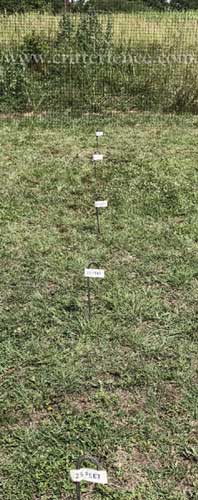How To Protect Roses From Deer
Mar 5th 2018

As the year turns towards spring are you dreaming of rose garden blooms coming soon? If so, be sure to act during late winter or early spring to protect rose gardens from hungry deer. For more information besides what is found on this page, please visit our main deer fence page: what is deer fence?
Rose
Care Practices Creates Deer Forage
Best practice tells us to cover rose bushes in the fall and prune in winter. Doing so ensures that dormant roses send up new shoots in early spring with new buds soon to follow.
In February and March deer that have survived the winter are at their hungriest. New growth on woody stems are a favorite early spring forage for deer. As winter recedes the deer find these tender shoots.
How to Beat Early Spring Deer Foraging
Late winter or early spring is the time to decide on a deer fence strategy to protect your roses. The earlier the better. A deer fence is the best way to make sure that spring growth on rose bushes is not damaged by grazing deer.
Install Temporary or Permanent Deer Fencing?
Are your roses spread throughout your landscape or planted together in a small area? Are visits from deer only in the spring or are deer a constant problem throughout the year? Consider these questions when deciding to install temporary or permanent fencing.
Temporary Deer Fencing
Temporary polypropylene deer fencing is appropriate if roses the rose are not planted together. A temporary fence is also a good solution for seasonal deer problems.
Six Reasons to Choose Temporary Deer Fencing
- Temporary deer fencing is easy to install
- Is easy to move
- Simple and convenient to store
- A snap to reinstall
- Easy to move around the yard as needed throughout the season
- Temporary fencing is good for plants that are not planted together
What to Look for When Choosing a Temporary Fence
Ground sleeves for securing the deer fence poles make the fence easy to manage. Install fence pole ground sleeves in the areas that need protection throughout the year. Ground sleeves with locking sets crews are best. Loosen to remove posts and tighten to secure posts.
Afterward you can easily put up and take down the deer fencing. As new cane growth begins in spring, move it to blooming bushes then take it down when the problem subsides. Ground sleeves can be capped and left in place for the following season left in the ground.
Permanent Deer Fencing
Three reasons to choose permanent deer fencing:
- If you have a small yard
- Choose if roses are planted together in a dedicated garden
- If deer are a consistent problem throughout the year
Permanent deer fencing is a dependable barrier. It will keep deer and other critters away from all your gardens every day of the year. It is also a good choice if you have many small areas. It's easier to enclose the entire yard then try and enclose many small areas.
What Kind of Deer Fencing to Stay Away From
Wood, vinyl or chain link are inferior materials for protecting rose gardens from deer. Deer can jump over fencing if they can see the fence material or a top rail, even if that fence is 8’ tall or higher. Stay away from fencing with large opening sizes greater than 2". Large opening size fence can trap deer and hurt or kill them. Electric fence is also not effective for wild animals including deer.
Why Polypropylene Deer Fencing is Superior
The best lightweight deer fencing material is invisible polypropylene. Deer will be aware a barrier is there but will not jump over what they can’t see. The best permanent deer fencing is invisible polypropylene because it uses less posts than metal deer fence but still keeps out deer.
Five Reasons Why Invisible Deer Fencing is Best
- Deer fencing blends into the background
- Will not block from your yard
- Does not block view from your home
- Does not block view into your garden
- Is proven effective at keeping out deer

In the photo above, a polypropylene deer fence is not very visible from 25 feet away.
What to Look for in a Deer Fence
Choose polypropylene fencing that is 650 pounds of breaking strength or higher for durability. Fencing should be finished on one edge for easy of re-rolling and moving as needed.
Fence openings should be 2 inches or less to prevent animals from getting caught. Seek fencing that has options for posts, gates and more barriers. These options will help deter smaller animals as well.
The best polypropylene fencing can be attached to existing trees or by installing fence posts as needed.
Deer Fence Checklist
- 650 pounds of breaking strength material or greater
- Finished on one edge
- Fence openings no greater than 2 inches
- Can accommodate posts, gates and additional barriers
Late winter or early spring is the best time to install fencing to prevent deer damage to your rose gardens!



